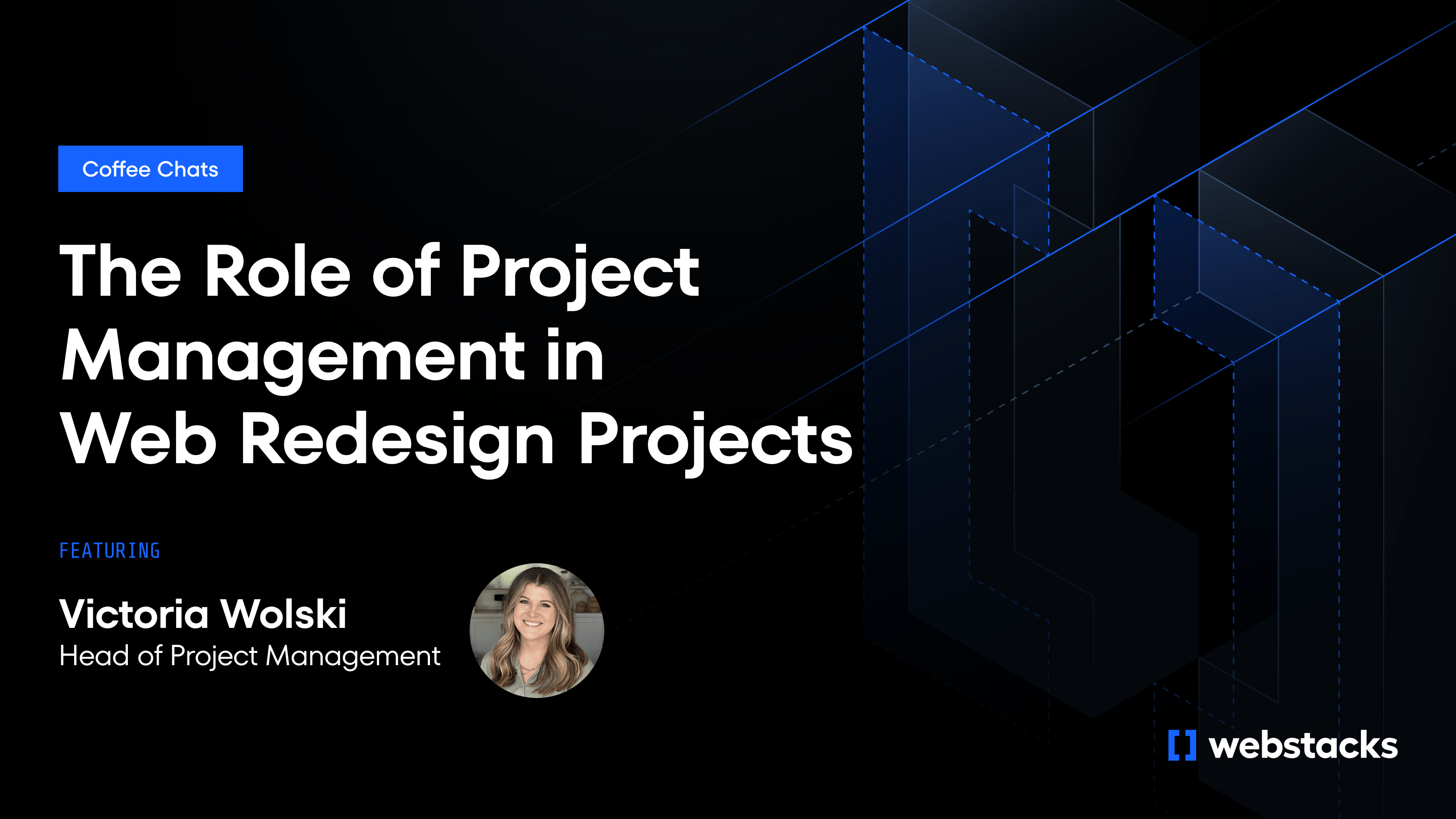I recently sat down with Victoria Wolski, Director of Project Management at Webstacks, to discuss how project management shapes web redesign outcomes. These projects are high-stakes for clients, requiring significant investment in an asset tied directly to brand identity and business outcomes. At the same time, these projects are technically complex, requiring coordination across strategy, design, development, and content teams, often while sharing responsibilities with the client's internal stakeholders.
Project managers sit at the intersection of all this complexity. Their job isn't just administrative coordination. It's ensuring the project delivers on its promise while maintaining client confidence and internal team alignment from kickoff through launch.
Where Project Management Fits
Project managers function as the connective tissue that holds redesign projects together from discovery through launch. Victoria describes the role as running through every phase of a redesign. "PMs are the connective tissue," she explains. "We're working with the teams internally, working with the clients, making sure that thread goes through from start to finish."
This continuity matters because redesigns involve constant decision-making across disciplines where strategy informs design, design constraints shape development feasibility, and development timelines influence content planning. Without someone connecting these workflows and ensuring each handoff includes the context the next team needs, projects fragment into disconnected deliverables that don't serve the original business goals.
Victoria points to two core responsibilities that define effective project management: empathy and execution discipline. "There's a certain finesse in having both," she notes. "We're constantly balancing trade-offs: scope versus velocity, priorities versus capacity."
That balance requires PMs to operate as high-level generalists with enough technical understanding to translate specs between departments, enough strategic thinking to align deliverables with business goals, and enough emotional intelligence to manage stakeholder expectations when priorities shift.
Proactive Planning as the Foundation
Effective project management starts before any design or development work begins. Victoria emphasizes that proactive planning (mapping phases, identifying dependencies, and building contingency into timelines) creates the structure that allows teams to move quickly without breaking things.
Webstacks divides redesigns into distinct phases, each with defined inputs, outputs, and handoff points between teams. Understanding these phases helps clarify where project management adds the most value.
How PMs Guide the Five Phases of a Web Redesign
Each phase builds on the previous one, creating a logical progression from strategic foundation to live site. The PM's role shifts at each stage, but the through-line is ensuring every team has what they need when they need it.
1. Rapid Immersion
This phase establishes the foundation by getting granular on scope, technical requirements, and stakeholder priorities. "In that Rapid Immersion phase, we start to understand what's happening in the project and refine the scope of work," Victoria explains. "We get granular: how many pages, what's being migrated, what's manual versus automated. That allows us to plan the rest of the timeline."
While the Web Strategy team conducts stakeholder interviews to surface priorities, technical constraints, and business context, PMs stay tightly connected to these conversations. This early alignment helps them anticipate friction points, understand the strategic intent behind the redesign, and map the decisions that will shape every downstream handoff. The goal isn’t just to gather requirements—it’s to establish shared context so the entire project starts with clarity.
2. Planning and Visual Exploration
Strategy and design begin translating business requirements into tangible deliverables through parallel workstreams. Strategy develops the information architecture, creating wireframes that show how content should be structured across the new site. Simultaneously, design conducts a web presence workshop to establish visual direction and brand positioning.
Victoria notes that this phase requires tight coordination between strategy and design: "Design and strategy during this phase are extremely connected. So when we do pass those wireframes off, design has that strong understanding of the expectations from content to functionality to the overall strategy behind the project."
The PM ensures both tracks progress in parallel without creating dependencies that slow momentum, while maintaining clear documentation so everyone understands how strategic decisions translate into visual and structural requirements.
3. Website Design
Designers create the actual page designs that will guide development, building a system of reusable components rather than one-off page mockups. Because Webstacks uses composable architecture, designers build atoms, molecules, and full components that can be assembled into multiple page types.
The PM facilitates regular design reviews with both internal teams and clients, ensuring feedback is consolidated and actionable rather than scattershot. This prevents the common redesign pitfall where endless revision cycles extend timelines without improving outcomes.
5. Technical Implementation
Development builds the site using the component system created during design. Victoria explains that Webstacks brings technical leads into projects earlier than many agencies to catch potential constraints before they become expensive problems.
During this phase, the PM balances heads-down build time with regular check-ins to verify that what's being built matches design specs and client expectations. QA happens iteratively at the component level rather than waiting until the end, which catches issues when they're easiest to fix.
6. QA and Launch
Comprehensive quality assurance ensures the site works as intended for both end users and content editors. "Our goal is to grow sites without complete overhauls every time," Victoria explains. "So we're looking at: can we easily edit this? Does it operate in the CMS the way a content manager would expect?"
This phase structure accommodates change rather than fighting it. When scope shifts or priorities evolve, teams can adjust without derailing the project because the foundational structure remains intact and everyone understands how changes in one phase ripple through to others.
Managing Internal and External Alignment
Structured touchpoints keep teams informed without disrupting their ability to execute focused work. Redesigns involve multiple internal teams working in parallel, often while coordinating with client stakeholders who have their own competing priorities. PMs maintain alignment through structured communication cadences: regular status calls, phase-specific workshops, and detailed agendas distributed in advance.
"We do regular meetings with all internal teams and client teams," Victoria explains. "Usually that's in the form of a status call where we review where we are in the phases, who's working on what. Often we're working in two or three phases at once."
These meetings keep everyone informed on progress and blockers while creating space for cross-functional collaboration. The key is finding the right cadence where communication supports execution rather than interrupting it.
Client alignment starts in the kickoff, where Victoria's team explains what clients can expect at each phase: stakeholder interviews during Rapid Immersion, web presence workshops during Visual Exploration, and regular design reviews during the Design phase. "We send out agendas. We send out the intent of all those calls," she notes. "At each step, we make sure the client understands: we're in this phase, this is what it means, this is what's coming up."
This transparency reduces uncertainty. Clients can reference their project plan and see where they are in the broader timeline. They know what's expected from them and when, which builds confidence even when the project encounters challenges.
Communication Models That Scale
The most effective communication approach varies by client based on organizational structure and preferences. Different clients need different levels of direct access to technical teams. Some prefer all communication routed through the PM, while others want direct collaboration between their developers and Webstacks' tech leads.
Victoria tailors the communication model to each client. "If it better suits the client to have one point of communication, we set that up," she says. "But at no point is it not okay for the tech lead to communicate with the client directly. More often than not, our clients have their own dev teams, and we need that level of collaboration."
This flexibility reflects Webstacks' positioning as an extension of client teams rather than a black-box vendor. Clients get access to the full team's expertise, not just filtered updates through a single point of contact.
Process Improvements That Matter
The single most important discipline in project management is eliminating assumptions through constant questioning and verification. Victoria's background spans multiple web agencies, giving her perspective on what distinguishes effective project management. One pattern stands out: assumptions kill projects.
"Ask all the questions," she advises. "If you think they're stupid questions, ask them anyway. Make sure you go into a project knowing every piece you could possibly know. I've seen so many projects go sideways because of assumptions, because of lack of clarity."
This applies to internal coordination as much as client communication. Departments often don't talk to each other enough unless the PM creates structured touchpoints. Leads within design or development may assume the other team understands their constraints or that someone else already flagged potential risks.
The PM's job is to eliminate those gaps through constant questioning, cross-checking, and documentation that ensures everyone operates from a shared understanding rather than creating bureaucracy for its own sake.
Why This Matters for Client Outcomes
Strong project management creates the conditions for successful redesigns by preventing the coordination failures that derail timelines and budgets. Weak project management almost guarantees problems: missed deadlines, scope creep, budget overruns, misaligned expectations, and teams working on outdated assumptions.
Clients don't always see the behind-the-scenes work that prevents these issues. They see the outcomes: a project that launches on time, delivers what was promised, and doesn't require constant escalations or firefighting.
Victoria frames it simply: "We create that balance through transparent communication, structured processes, and proactive planning. That allows our internal teams to do their best work while maintaining client satisfaction."
For B2B SaaS companies investing in web redesigns, this operational excellence matters as much as design quality or technical implementation. The website is critical growth infrastructure, and a poorly managed project creates technical debt, content gaps, and lost momentum that compound over time.
Working with a team that treats project management as a strategic discipline rather than administrative overhead means your redesign becomes the foundation for continuous optimization, not just a one-time deliverable that immediately needs maintenance.
Work with Webstacks to ensure your next redesign stays on track, on budget, and delivers the business outcomes you need.




